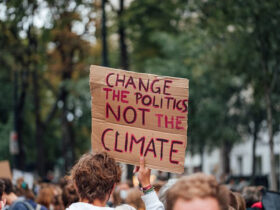By Molly Miller and Ruhi Ramesh
LOS ANGELES — On Oct. 31, the 2021 United Nations Climate Change Conference officially began. This conference, also known as COP 26, revisited the Paris Agreement to evaluate the progress countries have made towards meeting their climate targets and forecast what measures should be implemented to combat the threat of climate change and increases in global temperatures.
Conversations at COP 26 gave special attention to the carbon emissions question: Who is to blame for greenhouse gas emissions? The debate was a major point of contention at the conference, as developing nations such as China and India continue to argue against rapid emission reductions that are championed by developed countries such as the United States and the European bloc.
As delegates work towards finding solutions to the pressing climate problems facing the global population, many will be curious whether a compromise will be struck between the two sides — or if the blame game will continue.
Molly Miller: The UK Is To Blame for Global Emissions
Certainly, international cooperation is needed to combat climate change. Climate change is the very definition of a transnational issue. No single country can achieve meaningful results unilaterally. Nevertheless, the question of who is responsible remains pressing.
The costs of responding to climate change are large: estimates put the total cost at up to $50 trillion. Considering the magnitude of these costs and the fact that less-developed countries are disproportionately impacted by the effects of climate change, assigning responsibility is necessary to ensure that the burdens of responding to climate change are equitably shared.
Looking at historical carbon dioxide emissions, it is clear that Europe, particularly the United Kingdom, is responsible for far more cumulative carbon dioxide emissions than China. For example, the UK has generated 7 times more carbon dioxide emissions per capita from 1750 to 2018 than China. Furthermore, the rate of the UK’s declining share of cumulative carbon emissions has flattened out in recent years. Clearly, the UK has had an outsize impact on the carbon content of our atmosphere historically.
The UK’s substantial historical carbon emissions stem from one key source: the UK is the home of the industrial revolution. Certainly, industrialization has done well in raising standards of living worldwide. However, it is also the start of the explosion in carbon emissions which have been the root cause of climate change. The UK’s industrialization projects led to a massive increase in coal mining, kickstarting not only the release of carbon from the Earth’s crust but also large-scale habitat destruction. Even conservative elements of the UK have admitted that the UK needs to lead in climate policy.
The UK’s outsized impact on the climate extends even beyond industrialization on the European continent. For about 500 years, from 1450 to 1950, colonialism brought about British rule across large swathes of the world. The UK distributed its ecological practices throughout its colonial empire, displacing local methods of building and agriculture. This practice has hurt the ability of many colonized countries to adapt to changes in climate.
For example, in the Sundarbans, British colonizers cut down mangrove forests for timber and land clearing. The destruction of these forests eliminated the sources of construction materials and food for local communities. It has further left the coasts of this region vulnerable to erosion, magnifying the impacts of sea-level rise.
The legacy of colonial exploitation on the climate goes beyond the displacement of local best practices: it has also contributed greatly to environmental degradation and the loss of carbon sinks. The Amazon rainforest exemplifies colonialism’s exploitative, extractive legacy. The deforestation of the Amazon rainforest, which started during Portuguese colonization, continues under Jair Bolsonaro’s Brazil. This massive deforestation process has had dire consequences for the climate as a whole — including cutting down large swathes of forested land — leading to decreased rainfall, higher temperatures, a reduction in carbon drawdown and a potential feedback cascade which causes other climate “tipping points” to be crossed.
Clearly, the entire institution of European colonialism may be to blame for large portions of global carbon emissions. However, as the largest colonizer and most blatant industrialist, the UK shoulders the vast majority of this blame. Moreover, their ongoing lack of meaningful action only emphasizes the UK’s long term impact.
Ultimately, the “blame” for the atmosphere’s growing carbon content lies on the UK. The UK’s past emissions set the trajectory for today’s carbon emission rates. This does not mean that international cooperation in addressing climate change is unnecessary: far from it. Rather, it simply ought to inform our pursuit of equity in pursuing international climate policy. Europe must pay its fair share in addressing the harmful effects of climate change.
Ruhi Ramesh: Hold China Accountable
Although Europe, particularly the UK, has historically contributed the most to climate change, international environmental policy will be more effective with an inclusive “all in this together” strategy than a divisive and backward-facing “you broke it, you fix it” approach. As the current largest emission producer and investor in fossil fuels both domestically and abroad, China must take significant steps toward emissions reduction and climate change mitigation strategies.
In preparation for COP26, Europe’s climate chief said, “we need to talk to China,” pointing to the country’s immense contribution to global carbon emissions and relatively minor commitment to carbon reduction efforts. China has thus far resisted international pressure to revise its carbon reduction timeline, placing the onus instead on more developed countries.
China quickly emerges as the primary culprit when determining which country is responsible for the most carbon emissions. In 2019, China’s carbon emissions amounted to 14.09 billion tons of greenhouse gases, equating to 27% of carbon emissions globally. Although the United States’ per capita emissions still outpace China’s, the developing country’s rapid economic growth in the early 2000s caused the country to overtake the U.S. in terms of carbon emissions in 2006 and remain the leader today. China unequivocally surpassed the United States (the second-largest emitter of greenhouse gases) by almost double.
With 1,058 coal plants currently in operation in the country — forming half of the world’s coal capacity — there is no doubt that China disproportionately contributes to climate change and has thus far failed to sufficiently mitigate their emissions and fossil fuel production. Therefore, the onus falls on China to take substantial steps in order to combat the consequences of climate change in the future.
Last year, President Xi Jinping announced China’s plans “to have CO2 emissions peak by 2030 and achieve carbon neutrality by 2060.” China’s commitments to reduce its climate impact strongly parallel European goals, but its concrete actions fall short of meaningful change. For example, China has committed to producing 25% of its energy from renewable sources by 2030 and to reach carbon neutrality by 2060, which parallels EU’s goal of a 32% share of energy produced by renewables and carbon neutrality by 2050. Similarly, the 14th Five Year Plan lays out concrete mechanisms and strategies to attain China’s climate targets, indicating China acknowledges its responsibility to reduce emissions but continually procrastinates implementing sustainable development.
It is evident that the Chinese government is attempting to make good on its promise of hitting its carbon peak. Still, a significant issue with this climate pledge is the vague language surrounding the numerical amount of when this “peak” would be met.
In 2015, the Chinese government banned the construction of new coal-fired power plants to honor its pledge towards its carbon-neutral goal. However, in 2018, this ban expired, and in 2020, China ramped up its coal production again, creating three times as much coal-generating power capacity as all other countries in the world combined. This sudden surge in coal production capacity is due primarily to the desire of provincial governments around the country to stimulate economic growth in light of the slowdown caused by the COVID-19 pandemic. To facilitate this growth, Chinese governments have relaxed permit regulations and restrictions on coal-powered “megaprojects.”
As China looks to increase its production capacity within the manufactured goods market, electricity demands across the country have skyrocketed. To keep up with this demand, the government stated the country would increase its production capacity by 220 million metric tons of coal per year.
China has historically been against phasing out coal as a fuel source largely because, as a rapidly developing nation, the Chinese government believes it should receive the same opportunity to achieve industrialization that Western countries capitalized on in the previous century. Although China’s leadership argues that its people deserve the chance to achieve the same level of development and standard of living as Western countries already enjoy, if China waits until it has fully developed to implement sustainable technologies and practices, it will be too late to save the Earth from disaster.
Furthermore, China has exported this tension between development and sustainability to developing countries worldwide. For example, China’s Belt and Road Initiative (BRI), launched in 2013, is a massive initiative designed to spur economic growth by constructing highways, ports, railways, telecommunication towers and fiber optic cable routes. As a part of this initiative, Chinese banks and companies have played a crucial role in financing this infrastructure. Studies predict this development could, in fact, lead to a 2.7 C increase in global temperature — from the emissions of the countries involved in BRI alone.
During a six-month period during 2019, China invested $1 billion in coal-powered initiatives. The costs of constructing non-renewable infrastructure are twofold. First, the immediate consequences of BRI projects are increasing emissions and ignoring environmental costs, including declining biodiversity, deforestation and exacerbated air quality. Second, investing in fossil fuels now increases the future costs of switching to renewable energy. Each oil pipeline and coal-powered railroad that China bankrolls further entrenches developing countries on the path to ‘dirty’ development and adds to the burden of climate action for future generations. When promoting industrialization and development in less developed countries, China must prioritize renewable energy infrastructure over fossil fuel extraction.
The debate between industrialization and environmental protection excludes developing countries, such as the Maldives and Costa Rica, that are not positioned to benefit from industrialization yet will inevitably face the worst of industry-induced climate disasters. In fact, as preliminary climate agreements are drawn up in Glasgow, it appears as if India and China have attempted to water down the climate pledge to give themselves more time to take advantage of the industrialization benefits of using coal as a fuel source.
As the chief promoter and investor of industrialization directly impacting these smaller countries and vulnerable islands, China must adopt emission reduction strategies, green technology and other sustainable development strategies. If they fail to deliver on their promises — or continue pushing back the deadlines for action — the smaller countries caught in the crossfire between China and European countries like the UK will disappear.
Unfortunately, governments have been late realizing the harmful effects of climate change and even later implementing effective measures to combat its consequences. Moreover, as countries like China seek to take advantage of rapid growth in the shortest time possible, they are reluctant to give up the means to their ends.
While China may not be solely responsible for the current impending environmental disaster, there is no doubt that China is the number one player today. In addition to its large-scale emissions at home, China also has a strong influence on fossil fuel infrastructure internationally, further amplifying China’s blame for current global emissions rates. And in a world where China wants to win by industrializing quickly, the Chinese government and the international community must identify China’s critical role in helping the world avoid total disaster.
Conclusion
Although both China and the UK presented their respective arguments at COP26 discussions, which concluded Nov. 12, leaders from both countries ultimately reasserted their commitment to reducing greenhouse gas emissions and doubling down on climate change efforts.
In a joint statement with the United States, China agreed to step up its efforts to close the “significant gap” between previous climate promises and the reality of ongoing environmental conditions. The UK also doubled down on its efforts to eliminate fossil fuel production, surging toward the overdue elimination of the coal industry that launched the British economy into industrialization over a century ago.
Despite commitments from both countries to reduce emissions, most parties walked away from COP 26 negotiations with the knowledge that pledges fall short of necessary action. China signed on to climate agreements, but many onlookers doubt the prospects that China will willingly adhere to its commitments, considering the treaty is not legally binding and the language of the agreement now demands the “phase down” rather than phasing out of fossil fuels. UK Prime Minister Boris Johnson expressed disappointment at the diluted language of fossil fuel pledges and concern about forcing private coal producers to comply with the country’s shift toward renewable energy.
Regardless of the debate between British versus Chinese responsibility for carbon emissions, international experts, politicians and activists agree current efforts are not enough. All parties must take action to combat climate change, not just those who are the largest contributors.







